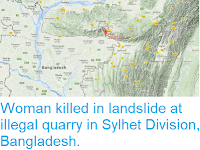Two children have died and twelve more people have been injured in a landslide in the Cox's Bazar District of Bangladesh on Tuesday 10 September 2019. The incident happened at about 6.00 am when a chunk of hillside collapsed onto the houses of two families in the village of Pallanpara, following several hours of heavy rain. Landslides are a
common problem after severe weather, as excess
pore water pressure can overcome cohesion in soil and sediments,
allowing them to flow like liquids. Approximately 90% of all landslides
are caused by heavy rainfall. The dead have been identified as Mehedi Hasan, 10, and Alifa, 5. In a separate incident another child from the same area, identified as Mohamed Khairul, 13, drowned in floodwater associated with the heavy rain.
The scene at a landslide that killed two children in the village of Pallanpara in Cox's Bazar, Bangladesh, on 10 September 2019. Bangla News 24.
Flooding, landslips, and related events are common in southern Bangladesh during the Monsoon Season, which lasts from June to October. Monsoons
are tropical sea breezes triggered by heating of the land during the
warmer part of the year (summer). Both the land and sea are warmed by
the Sun, but the land has a lower ability to absorb heat, radiating it
back so that the air above landmasses becomes significantly warmer than
that over the sea, causing the air above the land to rise and drawing in
water from over the sea; since this has also been warmed it carries a
high evaporated water content, and brings with it heavy rainfall. In the
tropical dry season the situation is reversed, as the air over the land
cools more rapidly with the seasons, leading to warmer air over the
sea, and thus breezes moving from the shore to the sea (where air is
rising more rapidly) and a drying of the climate.
Diagrammatic representation of wind and rainfall patterns in a tropical monsoon climate. Geosciences/University of Arizona.
Much of South and Southeast Asia has two distinct Monsoon Seasons, with a Northeast Monsoon driven
by winds from the South China Sea that lasts from November to February
and a Southwest Monsoon driven by winds from the southern Indian Ocean from March to October. Such a double Monsoon Season is common
close
to the equator, where the Sun is highest overhead around the equinoxes
and lowest on the horizons around the solstices, making the solstices
the coolest part of the year and the equinoxes the hottest. However
Myanmar is largely protected from the Northeast Monsoon by the mountains
separating the country from Yunnan Province in China.
The winds that drive the Northeast and Southwest Monsoons in Southeast Asia. Mynewshub.
See also...
Follow Sciency Thoughts on Facebook.









